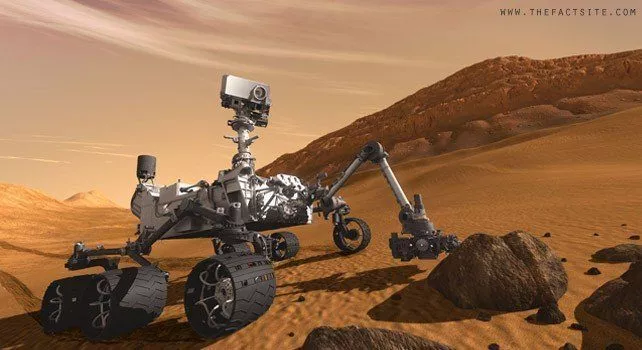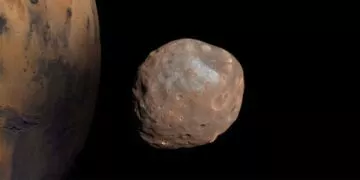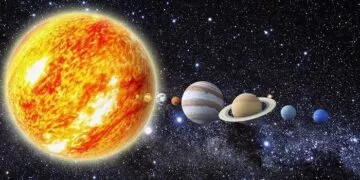Mars is one of the planets we can sometimes see from Earth with our naked eye.
Here are the top interesting facts about the planet Mars.
Out of all the planets in our Solar System, Mars is the one that people believe is most likely to have life of some sort.
The Martian day is 24 hours and 37 minutes.
Mars has polar caps like Earth, containing frozen carbon dioxide and a small amount of water too.
It is believed that Mars once had water flowing around it like Earth once. It is possible that it could have had a blue sky too.
Mars has seasons like Earth. This is caused by the tilt of the planet’s axis, at a similar angle to the tilt of Earth’s axis.
The tilt of Mars’ axis is 25.19°.
The Sun appears about half the size on Mars as it does from Earth.
Rocks from Mars have landed on Earth from meteorite impacts blasting debris through space.
The planet Mars was named after the Roman God of War because its color resembles blood.
In Greek, Mars was known as Ares.
Only 1/3 of all the missions to Mars have been successful.
Mars is commonly referred to as the ‘Red Planet’ because the surface of Mars is red.
Scientists first knew about the planet’s ability to produce water in 1971 as they discovered large volcanoes on its surface. This suggests that the planet likely warmed making it impossible for life to withstand the heat.
The Romans and Ancient Egyptians studied the sky and realized that Mars was a planet as was Earth. They and the Babylonians realized that Mars was further away from the sun than Earth.
The reason Mars is red is that it has iron oxide on its surface, which we commonly know as rust. This is what gives the planet Mars its reddish appearance.
The planet’s crust is anywhere from 50km to 125km thick. It is thicker than Earth’s crust which is about 40km.
The lack of vegetation suggests that dust storms are common on Mars. These storms are similar to those on Earth and will likely cause soil erosion over time.
Mars is roughly 141 million miles away from the Sun.
There is little protection from ultraviolet radiation on Mars as there is on Earth.
The temperature ranges from -140°C to 70.7°C throughout the year.
Mars is one-tenth of the size of Earth with a density of 3.933 grams/cubic centimeter.
Less mass suggests that Mars’ gravity is also less than Earth’s. This suggests that a person or object that is 100 pounds on Earth will likely weigh 38 pounds on Mars.
If the Statue of Liberty was built on Mars identically to the one on Earth it would weigh 84,825 kg less than it does on Earth.
Mars has about a third of the Earth’s gravity, which means that you can jump three times as high.
There are 687 Earth days in a Mars year.
The seasons on Mars are similar to Earth’s seasons, except that they are twice as long. This means Mars has a yearly cycle that humans could understand and adapt to.
It is far more likely for there to be life on Venus than Mars.
In the 1970s, the Viking orbiter took pictures of what appear to be giant faces and pyramids carved into the planet’s surface.
Mars has some of the wildest weather in the solar system. It has tremendous wind storms, dust storms, and small tornadoes.
In 2001, a huge dust storm covered the entire planet for several Earth days.
There are more storms on Mars when the planet is closer to the sun.
Mars has two moons, their names are Deimos and Phobos.
The moon Phobos orbits extremely close to Mars’ atmosphere. This means that one day, the gravitational pull with smash the moon to bits. The debris will stay in Mars’ orbit, which will form a ring-like the rings of Saturn.
Phobos and Deimos, named after the sons of Ares.
On November 13, 1971, the Mariner 9 reached Mars and officially became the first artificial satellite to orbit Mars.
The Mariner 9 was able to map out the Martian surface 100% and took the first close-up photos of Mars’ moons Phobos and Deimos.
In total, Mariner 9 took 7,329 photos of Mars and stayed in orbit for 349 days.
Viking 1 and 2 is the first-ever Mars mission to have a lander successfully reach the surface of Mars in 1976.
When the Vikings 1 and 2 launched nobody knew what the Martian surface looked like.
The Mars Global Surveyor was the first successful Mars mission in 2 decades. When it launched on November 7, 1996.
The Mars Global Surveyor took thousands of pictures of Mars.
If you tried to stand out on the surface of Mars without a spacesuit, you would die almost immediately.
Mars is the 4th planet from the Sun and the 7th largest planet.
The largest volcano in the Solar System is on Mars. It is called Olympus Mons, which is Latin for Mount Olympus.
Olympus Mons is 27 km high and 600 km wide. It is 8.85 km higher than Mount Everest.
Olympus Mons is a shield volcano, meaning it grew bigger and bigger due to the lava flows during eruptions.
The month of March was derived from Mars.
Mars’ moons were discovered by an American astronomer named Asaph Hall in 1877.
The diameter of Mars is roughly 4220 miles (6791 km).
The first spacecraft to visit Mars was Mariner 4 in 1965.
A Martian year is equal to 1 Earth year, 320 days, and 18.2 hours.
A mission to Mars was launched in late 2011. It is a larger and more advanced version of the Mars Exploration Rovers.
There are currently 12 man-made objects on Mars.
It is said that an alien skull was found on Mars.
Mars is about 1.5 times further from the Sun than Earth is.

















